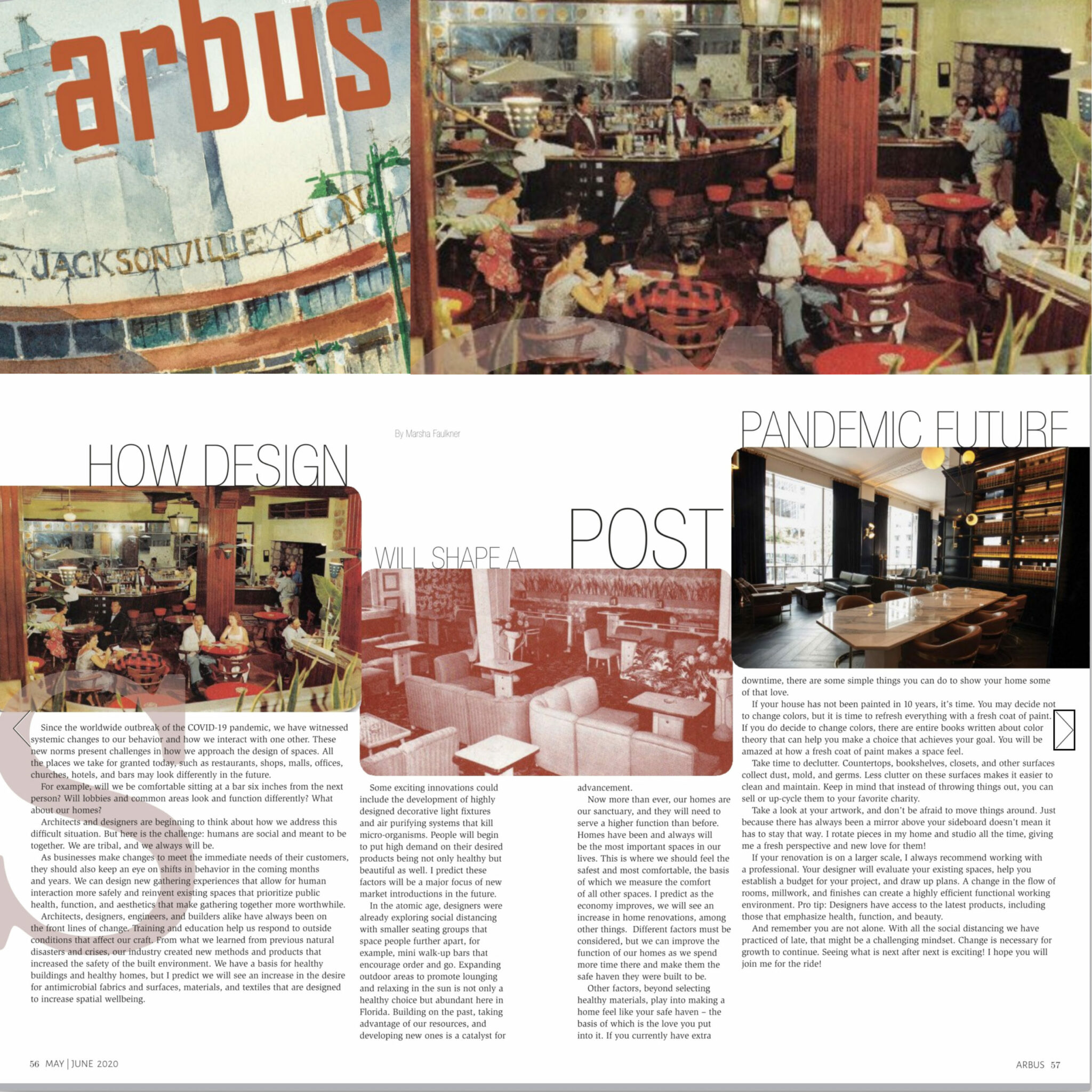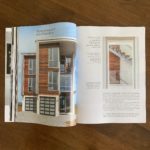I’m so excited to have been asked to contribute again this year in Arbus Magazine’s 24th annual Art + Architecture issue.
Since the worldwide outbreak of the COVID-19 pandemic, we have witnessed systemic changes to our behavior and how we interact with one other. These new norms present challenges in how we approach the design of spaces. All the places we take for granted today, such as restaurants, shops, malls, offices, churches, hotels, and bars may look differently in the future.

For example, will we be comfortable sitting at a bar six inches from the next person? Will lobbies and common areas look and function differently? What about our homes?
Architects and designers are beginning to think about how we address this difficult situation. But here is the challenge: humans are social and meant to be together. We are tribal, and we always will be.
As businesses make changes to meet the immediate needs of their customers, they should also keep an eye on shifts in behavior in the coming months and years. We can design new gathering experiences that allow for human interaction more safely and reinvent existing spaces that prioritize public health, function, and aesthetics that make gathering together more worthwhile.
Architects, designers, engineers, and builders alike have always been on the front lines of change. Training and education help us respond to outside conditions that affect our craft. From what we learned from previous natural disasters and crises, our industry created new methods and products that increased the safety of the built environment. We have a basis for healthy buildings and healthy homes, but I predict we will see an increase in the desire for antimicrobial fabrics and surfaces, materials, and textiles that are designed to increase spatial wellbeing.
Some exciting innovations could include the development of highly designed decorative light fixtures and air purifying systems that kill micro-organisms. People will begin to put high demand on their desired products being not only healthy but beautiful as well. I predict these factors will be a major focus of new market introductions in the future.
In the atomic age, designers were already exploring social distancing with smaller seating groups that space people further apart, for example, mini walk-up bars that encourage order and go. Expanding outdoor areas to promote lounging and relaxing in the sun is not only a healthy choice but abundant here in Florida. Building on the past, taking advantage of our resources, and developing new ones is a catalyst for advancement.
Now more than ever, our homes are our sanctuary, and they will need to serve a higher function than before. Homes have been and always will be the most important spaces in our lives. This is where we should feel the safest and most comfortable, the basis of which we measure the comfort of all other spaces. I predict as the economy improves, we will see an increase in home renovations, among other things. Different factors must be considered, but we can improve the function of our homes as we spend more time there and make them the safe haven they were built to be.

Other factors, beyond selecting healthy materials, play into making a home feel like your safe haven – the basis of which is the love you put into it. If you currently have extra downtime, there are some simple things you can do to show your home some of that love.
If your house has not been painted in 10 years, it’s time. You may decide not to change colors, but it is time to refresh everything with a fresh coat of paint. If you do decide to change colors, there are entire books written about color theory that can help you make a choice that achieves your goal. You will be amazed at how a fresh coat of paint makes a space feel.
Take time to declutter. Countertops, bookshelves, closets, and other surfaces collect dust, mold, and germs. Less clutter on these surfaces makes it easier to clean and maintain. Keep in mind that instead of throwing things out, you can sell or up-cycle them to your favorite charity.
Take a look at your artwork, and don’t be afraid to move things around. Just because there has always been a mirror above your sideboard doesn’t mean it has to stay that way. I rotate pieces in my home and studio all the time, giving me a fresh perspective and new love for them!
If your renovation is on a larger scale, I always recommend working with a professional. Your designer will evaluate your existing spaces, help you establish a budget for your project, and draw up plans. A change in the flow of rooms, millwork, and finishes can create a highly efficient functional working environment. Pro tip: Designers have access to the latest products, including those that emphasize health, function, and beauty.
And remember you are not alone. With all the social distancing we have practiced of late, that might be a challenging mindset. Change is necessary for growth to continue. Seeing what is next after next is exciting! I hope you will join me for the ride!
By Marsha Faulkner
https://arbus.com/how-design-will-shape-a-post-pandemic-fu…/




